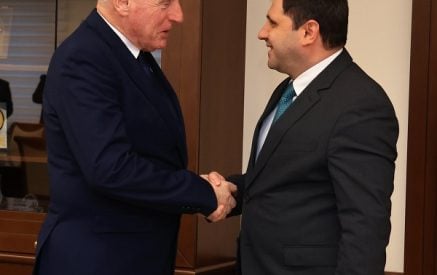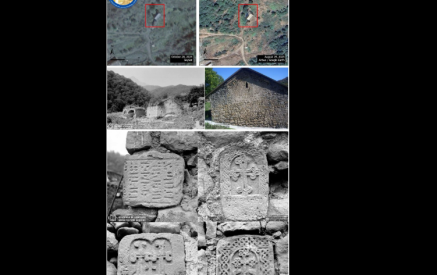The author and a fellow expedition participant atop Ararat’s summit
BY MEGHRI DERVARTANIAN
Throughout my childhood, I’ve learned, read, and seen many images of our holy mountain, Mt. Ararat. The image of her two beautiful silhouettes plastered on every Armenian paraphernalia is a symbol of Armenia’s instinctual will to survive. After 22 years, I was able to see with my own eyes, the image that has been engraved in my mind my whole life. It became a reality; this symbol became an experience and an icon of my journey. This was my first expedition, and I’ll be honest, I did not know what to expect, but all I knew was that I could not contain my excitement. From a young age I have always learned about this mountain, read about it, dreamed about it, yearned for it, and now I conquered it.
Read also
“You can see the ends of Historic Armenia” is what the climbers who summited Ararat before me had told me. That statement alone kept my nerves at bay as we all entered the questionable, almost Pre-Soviet Armenia looking bus headed to Bayazit near the mountain. The bus was packed and we were an odd group of climbers. Although we were not your typical mountaineers ready to traverse the harsh terrain, we were determined. We were a group of 47 people from 12 different countries with one common goal, which built an immediate connection between us all. We knew that this was just the beginning of an everlasting friendship.
Although most people will never climb Mt. Ararat, the mountain still looms large in every Armenian’s minds and hearts. Today, through my memoire, I hope that the looming notion turns from a thought to an achievable goal we can all strive for. Here’s an overview of what that journey entails.
Day one of climbing: It was going to take us three nights and four days to climb up and down Ararat. There were vans waiting in front of our hotel to take us to where we were going to start the climb. On the ride there, we had the vans stop on the side of the road and we all got out and danced kochari and yarkhoushta, starting our first day on the highest note possible. My smile was beaming like no other. I didn’t know if I should cry, laugh, or do both. I had to take a step back, breathe, and just take this all in.
We were hiking up to Base Camp 1 where we were going to spend the night. The distance from the bottom to Base Camp 1 was 4 miles, which took us four hours and 33 minutes. Those hours flew by as we sang and danced the whole way up, even during our “rest breaks.” There was no time to rest, the energy trickled from one person to the next. I had no idea of what to expect from the base camps. It felt as if we were at a mini panagoum (camp). After quickly setting up our tents and eating dinner, the “kef” continued. Although we had been hiking all day, the reality of being on Ararat was giving us the biggest burst of energy.
Day two was a little harder than day one. It was now a little chillier, and the climb was steeper and rockier than the first day. We woke up, ate breakfast, filled our water bottles and were ready to head out to Base Camp 2. The distance from Base Camp 1 to 2 was another four miles, and it took us about five hours to get there, with some breaks on the way, of course. At this point some people were getting more tired than others, but we were all determined to get each and every one of us to the top. We were a team — if one person wanted to take a break, we were all going to take a break. Throughout the hike we continuously asked one another if they were okay, and would scream from the front of the line to the back “inch gnekgor.”
Base Camp 2 was definitely much smaller and rockier than Base Camp 1. After putting up our tents, we were told to rest before and after dinner, because, at 12 a.m., we were going to start our track to the summit. Everyone was trying to rest, but how is it possible to sleep when you know that in a couple hours you are going to start hiking up to the top of Ararat?
At this point it was extremely frigid outside. I set my alarm for 11:30 p.m., but woke up before then. We started wearing our layers and packing our bags. I didn’t have a second to realize what was currently happening, as we all helped each other put our headlamps and gloves on, and made sure that everyone had the proper gear to start hiking. Our guides lined us up again and we started our hike to our next destination, the summit.
It was now pitch black, and the only thing you could see was what was directly in front of you. I was drained, but extremely energized at the same time. As we were climbing, we constantly pushed one another to keep moving. Something that I kept reminding myself is that this is our mountain — if we can’t make it to the top, if we can’t wave the Armenian flag on the summit ourselves, then who will? The distance from Base Camp 2 to the summit was two and a half miles. Six hours later, we saw the snow at the top of the mountain and it was time for the final push to the top. Our guides lined us up in one line again, and we were ready to slowly walk up through the snow.
As we got closer to the top, I looked at my friend Carnie and I screamed, “RUN,” she looked at me and without asking any questions we started to run. I felt like we were running for miles, when the top was just a couple feet away. Once we made it to the top I looked around me and didn’t know where I was for a second. I looked down and saw the rest of my group also running up, and then saw Armenian flags to my left and right. That’s when it hit me, I had made it. I dropped to the ground and started to cry. I had finally made it.
At that moment, nothing else mattered. At that moment it was just Ararat and us. At that moment, I was more sure than ever that Ararat will soon be ours again. I also know that one day we will climb Ararat without crossing any borders, and we will see the tri-colored flag waving at the top endlessly.
The climb down was definitely harder than our climb up. At this point my legs had given up on me, I felt as if I was skiing down on mud instead of snow. After falling countless times, we made it to Base Camp 1 where we were going to spend the night before hiking back down to the bottom. There was another group of Armenians at the camp who joined us as we sang and danced again, like no other. We celebrated our victory and proved that one’s purpose is stronger than any weakness that it might face.
We had all promised each other that we were going to leave no one behind. We were going to make it to the top together and come back down together, and we kept that promise. The famous proverb said, “If you want to walk fast, walk alone. If you want to walk far, walk together.” Our group was the embodiment of that proverb.
Ararat was not a challenge, because of her unrelenting height, harsh terrain, or even her unforgiving temperature; the challenge was conquering a symbol of our people, our dreams and our aspirations. The challenge was accepting the reality of being one with the mountain, breathing the air from her beautiful summit. Overcoming this challenge was a testament to our Armenian people and their instinctual will to survive. Together we will survive and hopefully the next time we meet on your beautiful summit, our shadow will cast on Armenia and the Armenian people will rejoice that our beautiful Mountain was conquered once again by her own beautiful people. Until next time, Ayskan Modenk, Paytz Garodenk.


































































